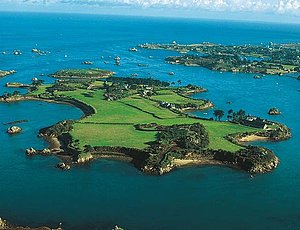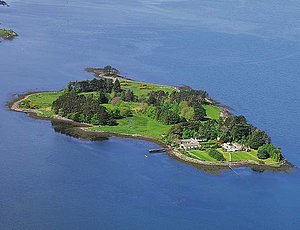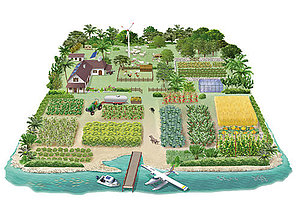Top 10 of Self-Sufficient Islands
Living self-sufficient on Private Islands
If an island can offer its owner not just a living space, but also drinking water and enough food to be able to have a healthy diet, we are talking about a self-sufficient island.
Every family which already tried to get by without the additional purchase of groceries knows that, after a while, one finds the best way to provide for oneself: Whether one decides to grow fruits and vegetables while buying meat and milk on the mainland, or to keep animals for oneself; whether one eats the fish from the surrounding waters or the fish from the fishermen of the next village—how independent one wants to be on one’s own island depends on the personal lifestyle and standards. And the island technology also requires individual planning: is a high tech satellite station preferred, or a simple telephone, a solar plant or a generator?
Almost every climate zone features islands that can be used as self-sufficient islands. A reliable rule of thumb from the days of the settlers of the 19th century goes thus: 2.5 acres of land are enough to feed one family. Regardless of whether the island owner wants to take up intensive farm work or seeks relaxation on his island—it is a rewarding feeling to be able to fall back on the riches of nature.
Île Biniguet, Brittany, France
There is pretty much everything one needs on this picturesque island near Brehat to live a self-sufficient life: from a little harbor to tenements, agricultural buildings, and altogether 44.4 acres of land, most of which is suited for gardening. Thanks to the chapel, even on Sundays one does not have to leave Biniguet.
Isola Santa Cristina, Venice, Italy
Santa Cristina, in the lagoon of Venice, had been inhabited by Benedictine nuns from as early as the 7th century, but remained abandoned for a long time from 1452. In the second part of the 20th century, a private business man discovered his love for the island and halted the imminent decline through extensive embankments and shoreline stabilization. Thereby, vegetable fields, orchards, and pools for fish farming and mussel cultivation came about. Today, vineyards are stretched out all around the residence, within which exquisite Cabernet, Merlot, and Chardonnay grapes grow.
Further Information on Santa Cristina for rent
Deenish Island, Ireland
Deenish Island is the perfect example of a self-sufficient island. Consisting of several slate-roofed residential and storage buildings, the small farm generates its own electric power using a solar system and a wind-powered generator. A well supplies drinking water for the whole island. The farmers have 51 acres of fertile land at their disposal, including an extensive orchard. Ferns and blackberry bushes have taken over fallow fields. Because the island is in private hands and receives only a few visitors besides the owners, it offers the ideal conditions for sea birds, and its breeding grounds have attracted various rare and endangered species. The EU has thus declared Deenish Island a Special Protection Area and bird sanctuary.
Sanda Island, Scotland
Sanda Island has around 45 acres of arable farmland in the middle, while the rest of the island’s almost 400 acres extends across hilly meadows, on which sheep graze in an idyllic setting. Guests who want to experience the rough charm of the Scottish coast in a completely pristine form can rent renovated rooms in a traditional farmhouse. The owner of the island is allowed to carry the title “Laird of Sanda,” issue his own stamps, and strike his own gold coins.
Further information on Sanda Island for rent
D’Arros Island, Seychelles
This protected private island nature reserve is a testament to environmentally-friendly living. As well as getting involved in a series of conservation projects aimed to encourage the growth of local marine life, the Seychelles’ D’Arros Island has also taken great steps to promote self-sustainability.
Galloo Island, Upstate New York, USA
Self-sufficiency should be no problem here. Encompassing almost 2,000 acres, Galloo Island is an all-American private island paradise. Located smack bang in the middle of Lake Ontario, Galloo boasts fertile earth, a herd of wild deer and even its own electricity. That’s right - thanks to its network of solar systems and wind turbines, your dream of a self-sustainable life doesn’t need to stop at what’s on the menu!
Motu Toahotu, Raiatea, French Polynesia
Located in the reef belt of Tahaa, Toahotu is surrounded by coral reefs and various species of fish. Snorkelers will find ideal conditions in the exceptionally clear, turquoise-blue water. The owner has built himself a tropical garden in which he grows various vegetables. Right next to it, vanilla beans and coconut palm trees grow on the fertile ground of the island. Water basins for fish farming complete the alternative and relaxing attitude to life of a self-supporter in the South Seas.
Tropical Zone
Most of the earth’s warmest climatic zone is characterized by the diurnal climate: The temperature differences between night and day are bigger than the differences between the monthly averages. The vegetation ranges from evergreen rain forests to savannas. More than 40 percent of the world’s population lives in the tropics—with an upward trend.













